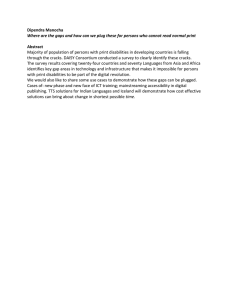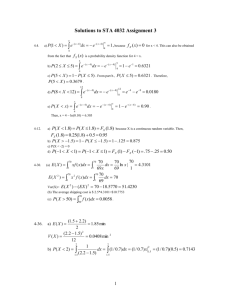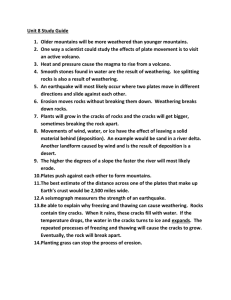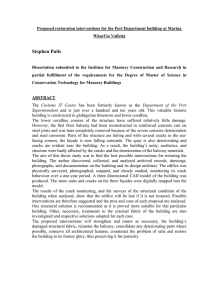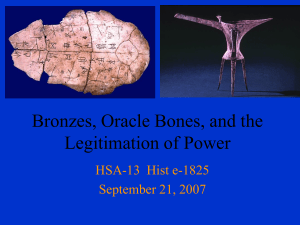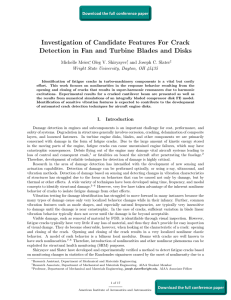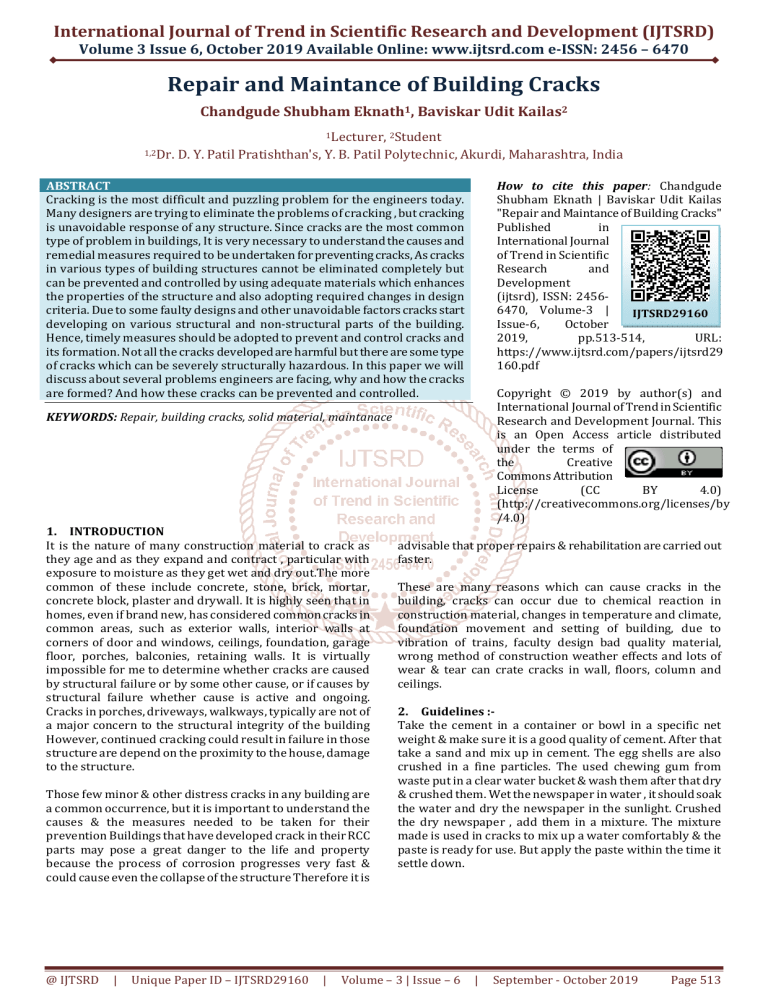
International Journal of Trend in Scientific Research and Development (IJTSRD) Volume 3 Issue 6, October 2019 Available Online: www.ijtsrd.com e-ISSN: 2456 – 6470 Repair and Maintance of Building Cracks Chandgude Shubham Eknath1, Baviskar Udit Kailas2 1Lecturer, 2Student 1,2Dr. D. Y. Patil Pratishthan's, Y. B. Patil Polytechnic, Akurdi, Maharashtra, India ABSTRACT Cracking is the most difficult and puzzling problem for the engineers today. Many designers are trying to eliminate the problems of cracking , but cracking is unavoidable response of any structure. Since cracks are the most common type of problem in buildings, It is very necessary to understand the causes and remedial measures required to be undertaken for preventing cracks, As cracks in various types of building structures cannot be eliminated completely but can be prevented and controlled by using adequate materials which enhances the properties of the structure and also adopting required changes in design criteria. Due to some faulty designs and other unavoidable factors cracks start developing on various structural and non-structural parts of the building. Hence, timely measures should be adopted to prevent and control cracks and its formation. Not all the cracks developed are harmful but there are some type of cracks which can be severely structurally hazardous. In this paper we will discuss about several problems engineers are facing, why and how the cracks are formed? And how these cracks can be prevented and controlled. How to cite this paper: Chandgude Shubham Eknath | Baviskar Udit Kailas "Repair and Maintance of Building Cracks" Published in International Journal of Trend in Scientific Research and Development (ijtsrd), ISSN: 24566470, Volume-3 | IJTSRD29160 Issue-6, October 2019, pp.513-514, URL: https://www.ijtsrd.com/papers/ijtsrd29 160.pdf Copyright © 2019 by author(s) and International Journal of Trend in Scientific Research and Development Journal. This is an Open Access article distributed under the terms of the Creative Commons Attribution License (CC BY 4.0) (http://creativecommons.org/licenses/by /4.0) KEYWORDS: Repair, building cracks, solid material, maintanace 1. INTRODUCTION It is the nature of many construction material to crack as they age and as they expand and contract , particular with exposure to moisture as they get wet and dry out.The more common of these include concrete, stone, brick, mortar, concrete block, plaster and drywall. It is highly seen that in homes, even if brand new, has considered common cracks in common areas, such as exterior walls, interior walls at corners of door and windows, ceilings, foundation, garage floor, porches, balconies, retaining walls. It is virtually impossible for me to determine whether cracks are caused by structural failure or by some other cause, or if causes by structural failure whether cause is active and ongoing. Cracks in porches, driveways, walkways, typically are not of a major concern to the structural integrity of the building However, continued cracking could result in failure in those structure are depend on the proximity to the house, damage to the structure. Those few minor & other distress cracks in any building are a common occurrence, but it is important to understand the causes & the measures needed to be taken for their prevention Buildings that have developed crack in their RCC parts may pose a great danger to the life and property because the process of corrosion progresses very fast & could cause even the collapse of the structure Therefore it is @ IJTSRD | Unique Paper ID – IJTSRD29160 | advisable that proper repairs & rehabilitation are carried out faster. These are many reasons which can cause cracks in the building, cracks can occur due to chemical reaction in construction material, changes in temperature and climate, foundation movement and setting of building, due to vibration of trains, faculty design bad quality material, wrong method of construction weather effects and lots of wear & tear can crate cracks in wall, floors, column and ceilings. 2. Guidelines :Take the cement in a container or bowl in a specific net weight & make sure it is a good quality of cement. After that take a sand and mix up in cement. The egg shells are also crushed in a fine particles. The used chewing gum from waste put in a clear water bucket & wash them after that dry & crushed them. Wet the newspaper in water , it should soak the water and dry the newspaper in the sunlight. Crushed the dry newspaper , add them in a mixture. The mixture made is used in cracks to mix up a water comfortably & the paste is ready for use. But apply the paste within the time it settle down. Volume – 3 | Issue – 6 | September - October 2019 Page 513 International Journal of Trend in Scientific Research and Development (IJTSRD) @ www.ijtsrd.com eISSN: 2456-6470 3. Table :Material type Medium- sized Solid Powderd No. Material Name Quantity Other Details 1 Cement Birla Gold 2.25kg M53 Grade 2 Sand Bhima River Sand 2.25kg 1/16 Size 3 Egg Shell Power Egg Shells 0.375kg White Coloured Shells 4 Chewing Gum Happydent Boomer 0.0133kg 0.0315kg Waste or new chewing gum used 5 Paper Waste Make newspaper wet first after that dry it & crushed it. Table:- Description of Solid Material. Newspapers 0.25kg and repair. Urgent repair will prevent future collapse of the building. The appropriate remedy to crack failure is such that its nature and causes should be investigated and established before repair; otherwise wrongly treated cracks will reappear after sometime. However, causes of cracks investigation should be more concerned with what, rather than who is at fault. This will help to rectify and improve on designs, supervision, and construction of buildings to avoid building problems. 4. Figure of Solid Material:- 7. References :[1] Advanced maintenance Technology Handbook on crack in building. (Causes and Prevention). [2] International Research Journal of Engineering and Technology (IRJET). [3] American Journal of Engineering Research (AJER). [4] International Journal of Science and Research (IJSR). Solid Material 5. Result :Using this material we repair cracks successfully at Lashkar Building. The material have good strength & it becomes dry in 7-8 hours completely. We can preserve or cure the cracks due to faulty design but we can't preserve the crack due earthquake. We have to preserve it by using chemicals, etc. In sever atmosphere upto 0.1 mm cracks are permitted. cracks occure due to, shear, flexural, and torsional deficiency. Abrupt curtailment of reinforcement bars. 6. Conclusion :After careful observation and study of the cracks in the building, their causes and a few solutions that could be applied to rehabilitate the building, including test of strength on structural members, it was concluded that most of the cracks are as a result of human carelessness in all the stages of construction. From the research survey, it was observed that each of the building team has great part to play in the cause of cracks in the building, and the results clearly revealed that most of the cracks in the building structure are not dangerous, except the case of the toilets at the ground floor, first floor, and the four corners of the edge of the second floor, and roof slabs, which need urgent intervention @ IJTSRD | Unique Paper ID – IJTSRD29160 | [5] Gebregziabhier Tekeste Teshome (2008), Durability Problems of 20th Century Reinforced Concrete Heritage Structures and Their Restorations, Paper, July 2008, Technical University of Catalonia, Barcelona. [6] Purwono, R. Tavio, Imran, I and Raka, I. G. P. (2007), Indonesian Concrete Code for Buildings (SNI 03- 28472002). With commentary, ITS Press, Surabaya. [7] Vandoros, KG., and Dritsos SE. (2008), Concrete jacket construction detail effectiveness when strengthening RC columns, Construction and Building Materials 22.3 (March 2008) p.264, Gale Art and Engineering Lite Package, Web, 19 May 2011. [8] Structural Cracks (Historic Conservation Group). Scotland Technical [9] www.historic-scotland.gov.uk [10] NameshKillemsetty (Department of Civil Engg. O. P Jindal institute of Technology, INDIA. [11] www.google.com/structuralcracks [12] International Journal of Innovative Research in Science, Engineering and Technology. Volume – 3 | Issue – 6 | September - October 2019 Page 514
